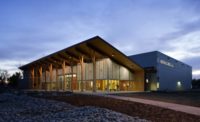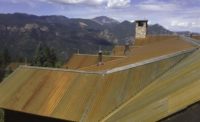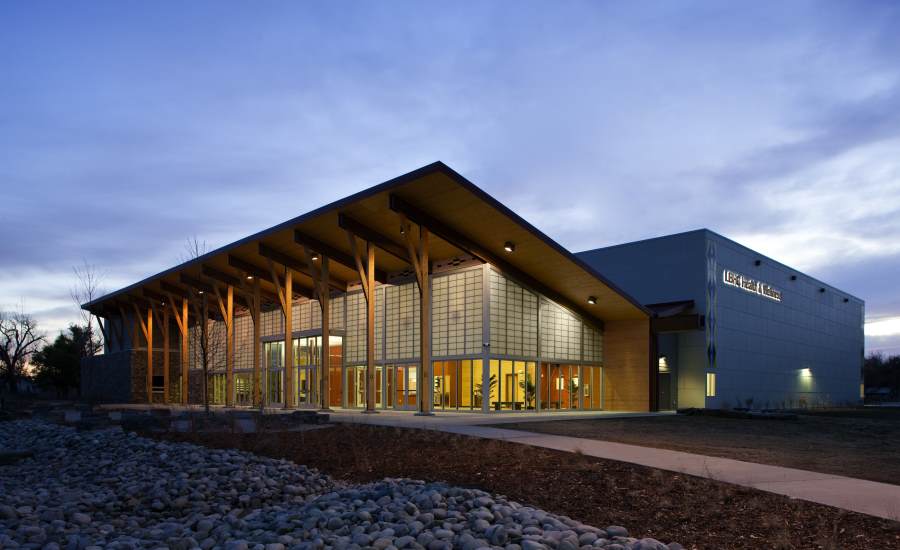Integrating SIPs with Metal Structure Buildings
Achieving High-Performance Building Envelopes








Although structural insulated panels (SIPs) often are used as the primary structural elements in light commercial and residential buildings, many project teams also use the panels as skins over metal structural frames to provide a high-performance building envelope.
A Case Study
To set the stage for why project teams combine SIPs with metal structural frames, it is helpful to review a specific example.
The Little Big Horn College Health & Wellness Center (Crow Agency, Montana) includes an NCAA gymnasium seating approximately 1,300 people; spaces for aerobics/community gathering, weight lifting and cardiovascular fitness; locker rooms; and support facilities. The college (of the Apsàalooke Nation—Crow Tribe of Montana) built the facility to serve its students, as well as the surrounding community.
The Health & Wellness Center project team faced a daunting schedule. Time was running out to use a government grant for the project, so the team needed to start construction (moving dirt and pouring the foundation slab) even before they finalized the building design. Adding to the timing challenges, they had to construct the building’s shell during one of the coldest Montana winters in 20 years.
On top of requiring rapid completion, the college wanted a very green, energy-efficient building targeted to LEED Platinum standards. This commitment to the environment reinforces the center’s role in supporting healthy living and respects the tribe’s historic, cultural and artistic way of life.
Since the owner, architect and general contractor used an Integrated Project Delivery (IPD) approach, all parties had a strong stake in working together to address the schedule and green building needs. Rather than operating under separate contracts for design and construction, with the IPD the participants all signed one contract focused on successful completion of the project. “This allowed every team member to bring their best ideas to the table and collaborate on solutions,” noted Scott Moore, project manager with BNIM Architects.
One of those ideas was to use SIPs for the exterior walls and roof. “SIPs meet a number of needs with just one system,” said Doug Morley, principal architect with Springer Group Architects. “They install fast, insulate well and are strong. Other than in the large gymnasium, this reduced the need for a secondary support structure in the building and saved a bunch of time and money.”
Echoing Morley’s comments, contractor Glen Kamerman, Partner with Kamerman Construction, said: “The SIPs were really accurately constructed and went together well. Using SIPs probably saved about 15-20 percent or better on the installation time. It also eliminated the need to heat the walls during winter construction, as would have been necessary with concrete masonry units.”
“SIPs really helped us meet the accelerated project schedule,” added Matt Anderson, owner of Compass Consulting Engineers. “SIP shop drawings were done concurrently with design, so by the time we released the foundation package, the SIPs were being fabricated in the shop. The erection was extremely fast and in no time at all we were dried in.”
In addition to rapid construction and high strength, the SIPs play a key role in the building’s high energy efficiency design. The large-size panels have fewer gaps requiring sealing than other construction methods and provide continuous insulation throughout the walls and roof. “Energy savings is a big part of getting to the LEED Platinum goal,” said Ben Mitchell, project manager with Fisher Construction, general contractor.
Reasons to Use SIPs
The 1,300-seat gymnasium portion of the Little Big Horn College Health & Wellness Center illustrates well the types of buildings that are especially suited for using SIPs as skins over metal structural frames. Specifically, buildings needing large, open interior spaces, and for which an energy-efficient envelope is crucial.
Two of the Little Big Horn College Health & Wellness Center project players summarize the role SIPs play in such spaces:
• “They work well in long spans and have high shear and diaphragm values. This was especially crucial to help create the wide-open space in the project’s gymnasium.” – Matt Anderson, owner of Compass Consulting Engineers
• “It’s hard to get a gym to meet any energy code, let alone LEED Platinum, but the SIPs provide a super energy-efficient envelope—much better than we could get from other products for the same labor and material costs.” – Ben Mitchell, project manager, Fisher Construction
In addition to gymnasia, other examples of buildings needing open spaces and an energy-efficient envelope include churches, community centers, cold storage and some factories and barns.
Looking for a reprint of this article?
From high-res PDFs to custom plaques, order your copy today!










